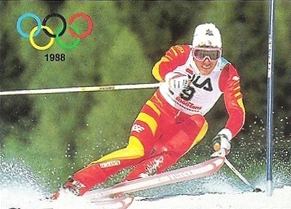Genre Alpine skiing | ||
 | ||
Location(s) EuropeCanadaUnited StatesJapan (rarely)Russia (rarely)Australia (rarely)Argentina (rarely)South Korea (rarely)New Zealand (rarely) Inaugurated 5 January 1967 (5 January 1967) (men)7 January 1967 (7 January 1967) (ladies) Organised by International Ski Federation People Markus Waldner (men) Atle Skårdal (ladies) | ||
The FIS Alpine Ski World Cup is the top international circuit of alpine skiing competitions, launched in 1966 by a group of ski racing friends and experts which included French journalist Serge Lang and the alpine ski team directors from France (Honore Bonnet) and the USA (Bob Beattie). It was soon backed by International Ski Federation president Marc Hodler during the FIS Alpine World Ski Championships 1966 at Portillo, Chile, and became an official FIS event in the spring of 1967 after the FIS Congress at Beirut, Lebanon. The first World Cup ski race was held in Berchtesgaden, West Germany, on January 5, 1967. Jean-Claude Killy of France and Nancy Greene of Canada were the overall winners for the first two seasons.
Contents
- Overall winners
- Overall titles
- Discipline titles
- Greatest alpine skiers of all time
- Ladies super ranking
- Most World Cup wins in each discipline
- Various records
- Most successful race winners
- 20 wins and more in SpeedTechnical Events
- Top results
- All event winners
- References
Competitors attempt to achieve the best time in four disciplines: slalom, giant slalom, super G, and downhill. The fifth event, the combined, employs the downhill and slalom. The World Cup originally included only slalom, giant slalom, and downhill races. Combined events (calculated using results from selected downhill and slalom races) were included starting with the 1974/75 season, while the Super G was added for the 1982/83 season. The current scoring system was implemented in the 1991/92 season. For every race points are awarded to the top 30 finishers: 100 points to the winner, 80 for second, 60 for third, winding down to 1 point for 30th place. The racer with the most points at the end of the season in mid-March wins the Cup, with the trophy consisting of a 9 kilogram crystal globe. Sub-prizes are also awarded in each individual race discipline, with a smaller 3.5 kg crystal globe. (See the section on scoring system below for more information.)
The World Cup is held annually, and is considered the premier competition for alpine ski racing after the quadrennial Winter Olympics. Many consider the World Cup to be a more valuable title than the Olympics or the biennial World Championships, since it requires a competitor to ski at an extremely high level in several disciplines throughout the season, and not just in one race.
Races are hosted primarily at ski resorts in the Alps in Europe, with regular stops in Scandinavia, North America, and east Asia, but a few races have also been held in the Southern Hemisphere. World Cup competitions have been hosted in 25 different countries around the world: Andorra, Argentina, Australia, Austria, Bosnia, Bulgaria, Canada, Croatia, Czech Republic, Finland, France, Germany, Italy, Japan, New Zealand, Norway, Poland, Russia, Slovakia, Slovenia, South Korea, Spain, Sweden, Switzerland, and the United States. (Note that all World Cup races hosted at ski resorts in Bosnia and Slovakia were held when those countries were still part of Yugoslavia and Czechoslovakia respectively.)
Lower competitive circuits include the NorAm Cup in North America and the Europa Cup in Europe.
Overall winners
Multiple individual overall World Cup winners are marked with (#). For a complete list of winners in each discipline, see Alpine Skiing World Cup Men and Alpine Skiing World Cup Women.
Overall titles
The following skiers have at least three overall alpine World Cup titles.
Discipline titles
Combined crystal globe was officially awarded from 2007–2012. However, there are counted all season titles, both official and unofficial. The records for most World Cup titles in each discipline are as follows:
For a complete list of winners in each discipline, see Alpine Skiing World Cup Men and Alpine Skiing World Cup Women.
Greatest alpine skiers of all-time
Based on ski-database super ranking system (since 1966). This is a scoring system calculating points together from three categories: Olympic Games, World Championships and World Cup (overall titles, discipline titles and individual top 10 results).
Ladies' super ranking
Most World Cup wins in each discipline
The records for most World Cup wins in each discipline are as follows (as of 22 January 2017):
Various records
NOTE: Only crystal globe awarded discipline officially counts as titles. And medal's awarded DH, GS, SL disciplines in seasons 1967-1977 as well. Combined crystal globe was officially awarded only in seasons 2007-2012.
Most successful race winners
A common measurement of how good individual skiers are is the total number of World Cup races won during their skiing career. The following skiers have won at least 20 World Cup races:
See also the complete list of FIS Alpine Ski World Cup race winners – MenAs of 4 March 2017
As of 25 February 2017
20 wins and more in Speed/Technical Events
Top results
All-event winners
Only a few of the most versatile racers have ever managed to win races in all five World Cup alpine skiing disciplines during their career, as listed in the table below. Marc Girardelli (1988–89), Petra Kronberger (1990–91), Janica Kostelić (2005–6) and Tina Maze (2012–13) are the only skiers to have won all five events in a single season. Of these, Tina Maze is the only one to have won five different events in a row within a single season (2012-13, between December 16 and March 2). Bode Miller is the only skier with at least five World Cup victories in all five disciplines. Since the combined was not introduced until the 1974–75 season and the Super G until 1982–83, the following list also includes those racers who won races in all disciplines contested during their World Cup careers (events not contested are marked by NA).
